Bollywood Dreams
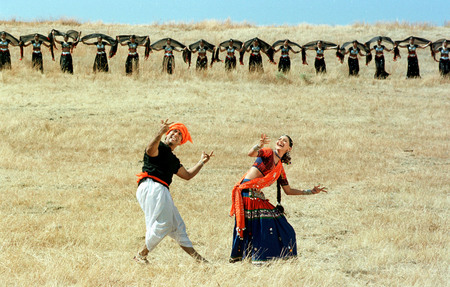
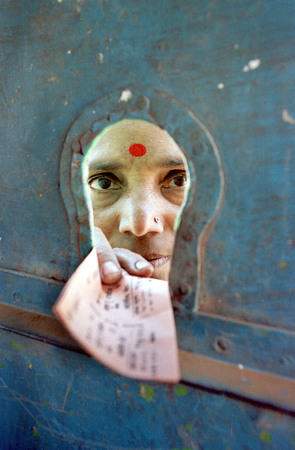
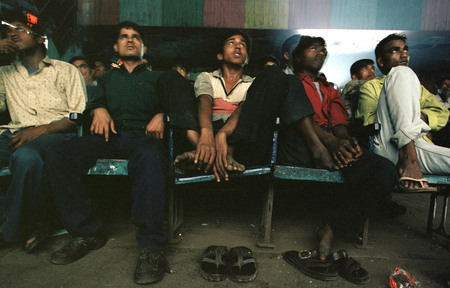
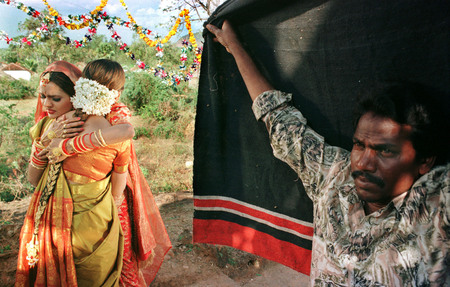
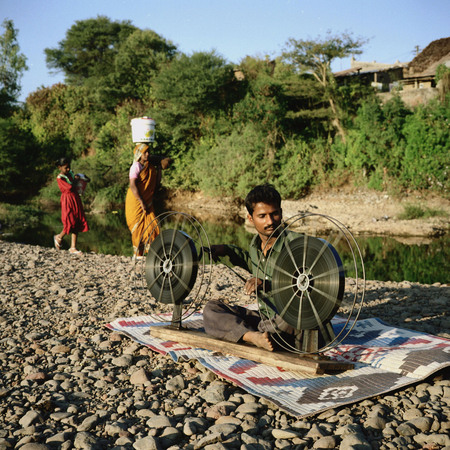

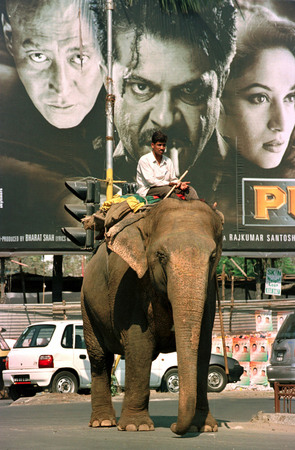
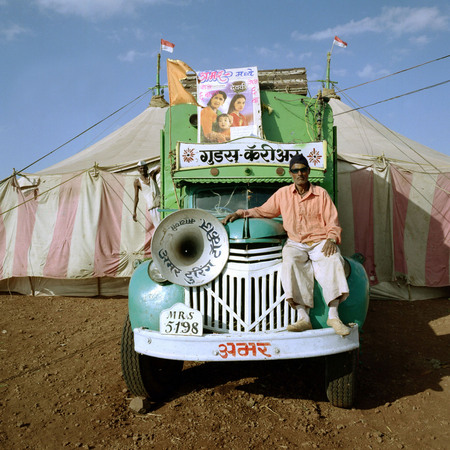
Jonathan Torgovnik. Govinda and Sunali Bendre during a song sequence on the set of “In the Land Where the Ganges Lives”; Panjgani, Maharashtra. Actors Govinda and Sunali Bendre, during a song sequence on the set of “Jis Desh Mein Ganga Rehta Hai”. 2000. Presented by Admira, Milan
Jonathan Torgovnik. Like in the trains that have special compartments for ladies, there are also separate box office counters for women. This comes from social norm that women should not need to come in close proximity with men who are strangers. 2002. Presented by Admira, Milan
Jonathan Torgovnik. The front row of New Shirin Cinema in Mumbai (Bombay), while the film is projected. The cinema is divided to sections and ticket price. The people which sit in the front rows are considered the biggest fans. 2002. Presented by Admira, Milan
Jonathan Torgovnik. Actresses Madooh and Urmila embrace, and a film crew man blocking the light from the camera by hand holding a black cloth. As labor is very cheap in India, this film crew worker is acting as a human “flag” for blocking the light. 1997. Presented by Admira, Milan
Jonathan Torgovnik. A crew member of Amar’s touring cinema rewinding film reels between shows, on the river bank where the cinema camped in the village of Palli. 2002. Presented by Admira, Milan
Jonathan Torgovnik. In the court yard of “Roopam” cinema in Chennai (Madras). A boy stretching his hand, trying to touch the lips of a painted larger than life image of his favorite actress film star. 1997. Presented by Admira, Milan
Jonathan Torgovnik. Cinema billboard advertising the film “Pukkar” and an elephant merging with rush hour traffic on Juhu Beach Road, Mumbai (Bombay). 2000. Presented by Admira, Milan
Jonathan Torgovnik. Amar Touring Cinema camped in the village of Palli, with Kisan the projector operator sitting on the truck. 2002. Presented by Admira, Milan
Moscow, 16.03.2005—10.04.2005
exhibition is over
Zourab Tsereteli Gallery of Fine-Arts
19, Prechistenka street (
opening hours: 12:00 - 20:00, Friday 12:00 - 22:00, Sunday 12:00 - 19:00, day off - Monday.
Tel: + 7 (495) 637-25-69
Share with friends
Project presented by Admira, Milan
For the press
«In India going to the movies is a great event: to see the actors, who on the screen look larger than life; to spent a couple of hours dreaming a dream; to forget the concerns of everyday existence... Just like going to a temple to worship the gods, people go to the cinema to show their admiration for the actors, who with their bare hands easily kill a dozen men and who love the magnificent heroines. In a certain sense this is like a religion».
Masala films (local recipe with the main ingredients being: action, romance, violence, music, dance and a moral message) attract millions of viewers daily. This figure makes Indian cinema production the largest in the world. Some 500 thousand people are involved in the business, which is popularly called Bollywood. This cultural phenomenon absolutely fascinated Jonathan Torgovnik (Israel, b. 1969) during his first visit to India and gave rise to a desire to further investigate its sources and forms in the course of many subsequent trips. Personal contacts with local film makers made it easy for Torgovnik to appear both on the stage set and outside it.
Contrary to some other works devoted to the theme, Torgovnik decided to set aside the simplistic irony of a Western man towards this form of national cinema, always repeating itself and being at the same time predictable and unbelievable. Torgovnik tried to analyze every element of this phenomenon and his inquisitive and respectful attitude helped him conduct an authentic anthropological study — serious and at the same time exciting.
Jonathan Torgovnik begins his journey with looking at the very essence of the process: he visits the sets of large production studios, photographs the mise-en-scenes and the main heroes. He is puzzled by the presence of thousands of faces and by impossible turns of the plot. The creators of these motion pictures, which in terms of genre lie somewhere between a musical and an epic, are often inspired by social issues or use traditional forms: the story evolves around a certain family, it reflects particular features of Indian society. But there is no effort to seem realistic, none at all. What is important is to touch the most sensitive cords in the heart of the widest audience, which in return is ready to worship the favorite actors who play the leading roles. The faces of female stars are looking everywhere from billboards, hung high up in the city center. Hand-made posters, introducing new movies, decorate almost every street. With his eloquent images Torgovnik shows how impressive they are. But he also documents the events behind the screen, in the workshops, where hundreds of artists create the captivating image of a movie star.
However it is not only the set and the star craze — the myth is omnipresent. It also manifests itself in the lengthy lines of sitting movie-goers that are formed in front of the box-office long before the show begins. Or in the magnificent odyssey of vagrant cinematographers — small trucks, carrying the magic shots to the most outlandish places, to remote villages, many-days-journey away from the closest movie theatre. The vehicles transport, apart from personal belongings, such as bedclothes, whatever is needed to show a film: a hall with a large screen under a canopy, which is able to house hundreds of viewers, a projector and different useful things, such as a device to rewind the film manually after a show.
Jonathan Torgovnik revives this world and offers us a wealth of information, so that we could transcend the impression of banality and commonplace primitivism. He has worked on the subject for five years, constantly on the move between India and New York where he presently lives. «In the movie-industry everything happens very slowly, things lag infinitely long. Everyone has to wait all the time, especially for the arrival of the leading star, who is always late because of being involved in some other film». The actors, revered like gods, have such an influence on the common people, that they are often invited to join some political party. «However cinema still remains a sacred territory, free of any political conflicts. For example many of the superstars are Moslem, and this occurs in a country inhabited predominantly by adherents of Hinduism. But when one is talking movies, this does not mean a thing; ethnic, social and political issues are completely forgotten. This example can give an idea of the power of cinema».
Enrica Vigano


